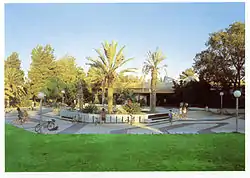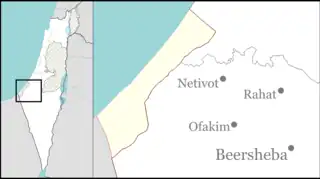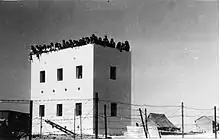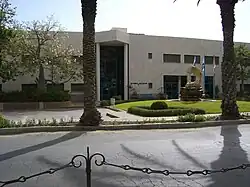Hatzerim
Hatzerim (Hebrew: חֲצֵרִים, lit. Farmyards) is a kibbutz located 8 kilometers west of Beersheba in the Negev desert in Israel. It is named after the Bible (Deuteronomy 2:23),[2] mentioning a site nearby: "the Avvites who lived in farmyards as far as Gaza". It belongs to the Bnei Shimon Regional Council. In 2021 it had a population of 857.
Hatzerim
חֲצֵרִים حتسريم | |
|---|---|
 | |
| Etymology: Farmyards | |
 Hatzerim  Hatzerim | |
| Coordinates: 31°14′25″N 34°42′51″E | |
| Country | Israel |
| District | Southern |
| Council | Bnei Shimon |
| Affiliation | Kibbutz Movement |
| Founded | October 1946 |
| Founded by | Israeli Scouts |
| Population (2021)[1] | 857 |
| Website | www.hatzerim.org.il |
History
The community was established in October 1946 by a young group of scouts who were then later joined by Polish-Jewish refugees from the Soviet Union; they reached Israel via Iran with the Polish Army, referred to as "The Children of Tehran" ("Dzieci Andersa" in Polish). They then learned agriculture and military training becoming part of the Haganah ground forces.

In the 1960s, the Hatzerim Airbase was built nearby. Hatzerim is now a well developed kibbutz (one of Israel's richest) due to the profits from Netafim. The kibbutz has amenities such as a library, swimming pool, dentist and a zoo.

Netafim

Hatzerim was one of the first kibbutzim (pl.) to break the mould from traditional agriculture and start a business. Netafim is the kibbutz business that started in 1965, that designs, manufactures and distributes irrigation systems. The business is also run with two other kibbutzim, Magal and Yiftach. There are also factories around the world, California, USA, South Africa, Western Australia and more. Netafim soon became a world leader in their field as a multinational corporation that grosses over $300 million a year. Hatzerim also produces jojoba oil. There are fields all around the kibbutz.[3]
References
- "Regional Statistics". Israel Central Bureau of Statistics. Retrieved 22 February 2023.
- Carta's Official Guide to Israel and Complete Gazetteer to all Sites in the Holy Land. (3rd edition 1993) Jerusalem, Carta, p.192f, ISBN 965-220-186-3 (English)
- Professor Roger Hayter. "Dynamics of Industrial Location - A Kibbutz-based MNC". Simon Fraser University (sfu.ca).
Further reading
- Gavron, Daniel. The Kibbutz: Awakening from Utopia. Lanham, MD: Rowman & Littlefield, 2000.
External links
- Kibbutz website (in Hebrew)
- Netafim Website (in English)
- Hatzerim Dance Studio and Dance Company Archived 2015-08-01 at the Wayback Machine